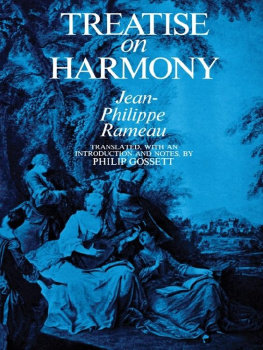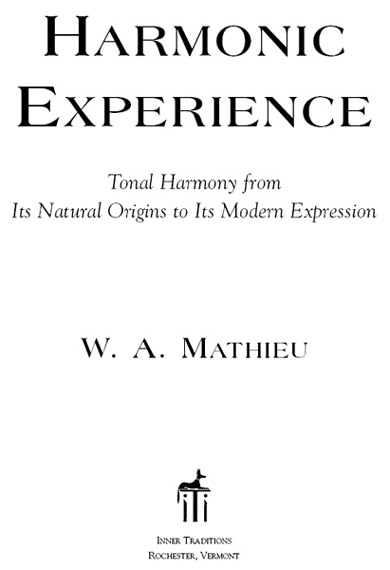To Pandit Pran Nath
19181996

ACKNOWLEDGMENTS
I WOULD FIRST LIKE TO ACKNOWLEDGE my teachers, Buddy Hiles, William Russo, Paul Sills, Easley Blackwood, Viola Spolin, Samuel Lewis, Pir Vilayat Khan, G. S. Sachdev, Terry Riley, Hamza El-Din, and Pandit Pran Nath, for allowing me to define myself and my work through their vision. Pandit Pran Nath, who passed away during the final preparation of this manuscript, has left behind through his recordings and through the voices of his students a golden legacy of transcendant music.
I give thanks also to my counselors Ben Johnston and Will Johnson for their timely support and pragmatic criticism. Many thanks to my students and friends Bob Fuller, Carol Frick, Jack Leissring, David Balakrishnan, Matthew Goodheart, Connie Coleman, Debra White, and Lori Levy for their grace and grit while I experimented on themwell, through them, perhaps.
I would like to thank the many people who have helped directly with the production of the book. Marie Carmichael and Francis Martineau read the manuscript and helped make it cogent. Dave Fraser helped develop many of the harmonic models. Kathleen Seidel procured the tapes of Mr. Creel and Dr. Boomsliter, as well as additional texts. Scott Makeig supplied copies of his own work as well as highly stimulating conversation. Marc Savage and Charlie Stevens provided invaluable assistance in compiling an index. And with the most profound generosity, Kirk Whipple supervised the production of over nine hundred musical examples, greatly improving their visual clarity and sustaining the highest standards of craft and musicality. Cory Gray aided us in this project with unflagging spirit, Virginia Cayton helped keep us organized, and Marilyn Morales provided us heartfelt and tactical support.
The editor of Harmonic Experience, Larry Hamberlin, has been not only its champion but also its fine-tuner, wetnurse, pilot, diplomat, and salesman, as well as its authors friend, and I thank him profoundly for all of these dimensions. Deep thanks also to Christine Sumner, Virginia Scott, and the staff of Inner Traditions International for their long patience and great resourcefulness.
And finally, to my three daughters, Athene, Lucy, and Amy, and to my wife, Devi, eternal gratitude.
EDITORS PREFACE
MY WIFE TELLS ME that her adult music students often begin lessons with this request: I want to play better, of course, but what Im really hoping to learn is how music works. The wording may varysome say they want to learn harmony, others music theorybut the underlying need is the same: A hunger to understand how music exercises its power over our psyches.
What those students are often surprised to learn is how many professional musicians feel the same hunger. Even after years of university or conservatory training, most musicians still sense that a large piece of musical understanding is missing. Conventional music theory courses have taught them how to label different musical elements, identify chord progressions, and notate what they hear. They may indeed have learned something valuable about how music works, but what remains missing is a clear idea of how their own perceptions and responses fit into the picture.
The insatiably curious among us begin to search outside the usual sources of instruction to find an answer to that question. In my own journey as a composer and performer, that search has included playing African mbira music, exploring European tuning systems that predate equal temperament, and cracking my skull on the esoteric writings of Pythagorean philosophers. Each of these sources has supplied another piece of the puzzle, but generally Ive found myself on my own when it came to relating the useful bits and pieces to one another and to the actual music I want to make.
I had already spent a couple of decades in this search before I crossed paths with W. A. Mathieu, a musician who not only had covered much of the same lonely territory before me but had also managed to synthesize his knowledge into a teachable form. A pianist and composer in both jazz and classical traditions, as well as a longtime student of North Indian singing, Mathieu has developed an approach to self-training in harmony that focuses on the listeners response to combinations of tones. He takes as his starting point the phenomenon that comes closest to being a universal part of human experience: Our attraction to music that is in tune. That quality of being in tune is called resonance, and just as tones in correct relationships resonate together, so do we, as listeners and performers, resonate along with them. Mathieu shows us how, by singing and playing various combinations of notes in tune, we can learn to observe our changing responses and begin to develop an understanding of musics power based on what happens in our own bodies and minds.
Harmonic Experience begins with the fundamental building blocks of musicsingle tones, sung over a droneand shows you how to examine in minute detail your own responses to pure resonance. As you gain a conscious appreciation of these responses, a map of musics inner geography starts to emerge. Once those responses are mapped, the same process of attentive listening and introspection is applied to the impure tunings of equal temperament, which we are able to accept as more or less reasonable facsimiles of the genuine article. The next step, then, is to examine how the ambiguities of equal temperament make possible a harmonic language of exquisite subtlety and beauty.
Such a regimen of careful listening reveals to us not only how music works but also how it works in us. The one prerequisite, beyond the ability to read music, is a willingness to do the practices. Reading the book will put ideas into your head; singing, playing, and listening will put knowledge in your heart.
Mathieus approach is at once so simple and so profound that musicians working in any style and at any level can profit from it. Savvy readers may recognize elements of North Indian music theory and jazz theory in addition to orthodox classical ideas. Thats not because his method is some sort of eclectic New Age blend. On the contrary: His theory embraces so many musical traditions because it takes as its starting point the essential physical and psychological facts common to all music. It seems fitting that such a book should appear at a time when many musicians are dissolving the artificial boundaries between musical styles; those musicians will find this book an invaluable tool in the conciliation of opposing views.
In a time when we are inundated with throwaway books, Harmonic Experience definitely falls in the category of durable goodsa book to return to again and again. The books structure resembles a spiraling ascent up a mountain: The same vistas keep coming into view, but from successively higher vantage points. Once the journey has been made, you may choose to revisit parts of the mountain, avoiding the switchbacks and bushwhacking straight up to keep one vista constantly in sight. But any way you journey on this mountain, your relationship with music is certain to be illuminated and enriched by Mathieus gentle wisdom.
Larry Hamberlin
Rochester, Vermont
INTRODUCTION
HARMONIC EXPERIENCE DESCRIBES THE FULL RANGE of harmony, from its fundamental gestures to its most complex expressions, by means of the unifying principle of resonance. By harmony I mean not simply chord progressions but the relationships of all the notes in a piece both to the keynote and to each other. By resonance I mean those specially reenforcing combinations of tones that in their mutual resoundingtheir perfect in-tune-nessevaporate the boundary between music and musician.











